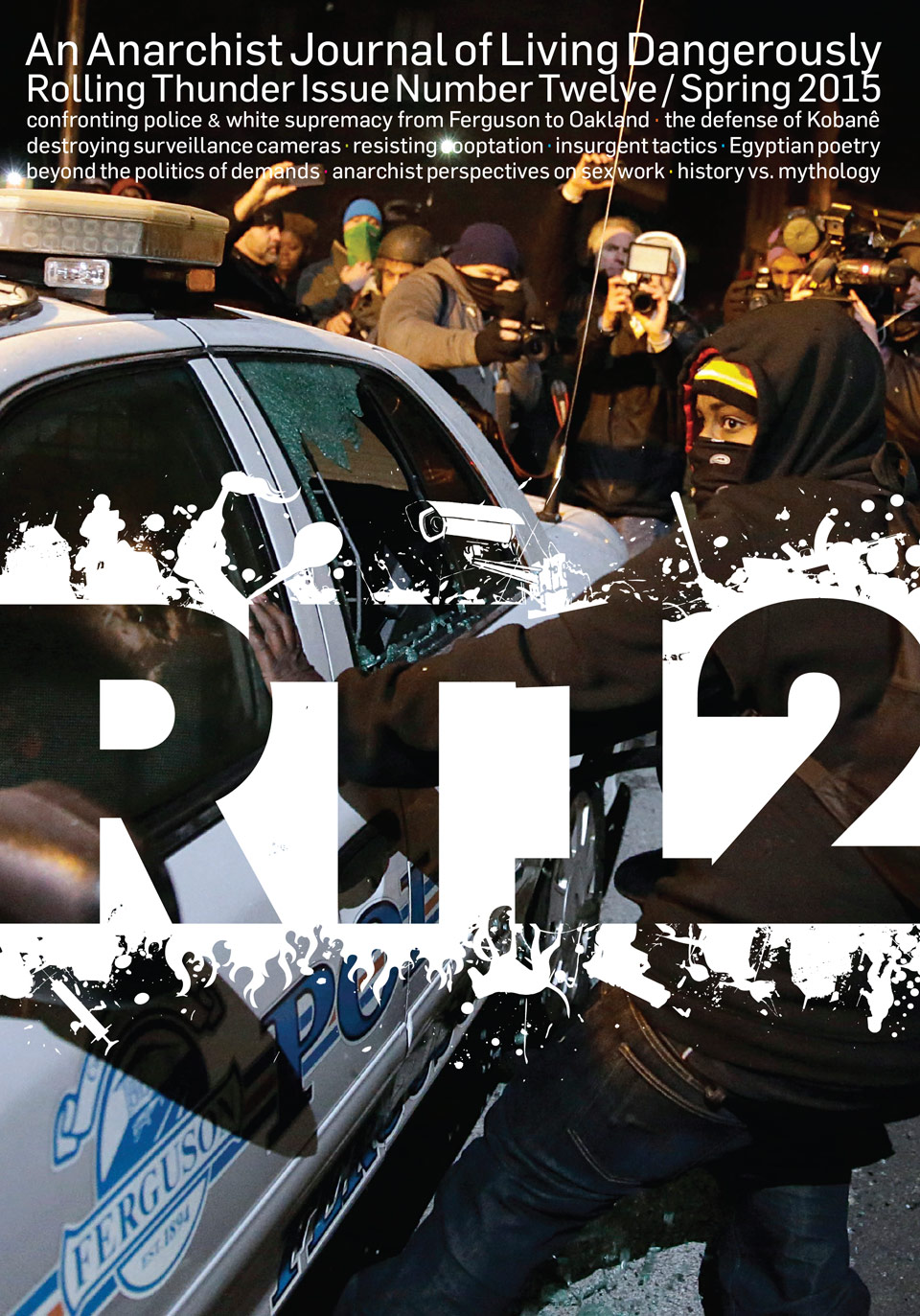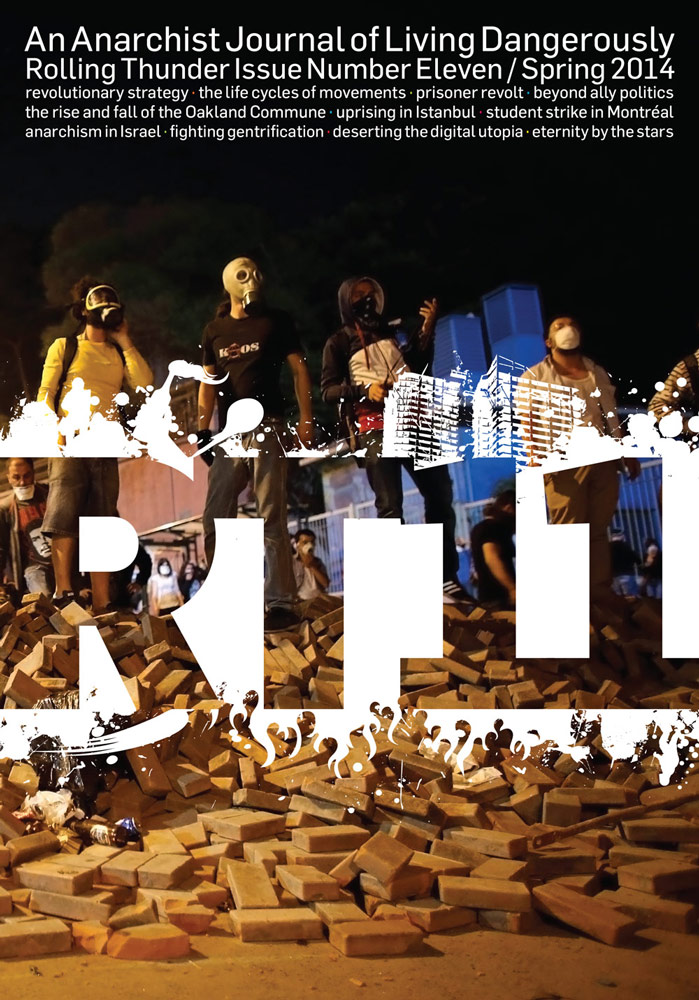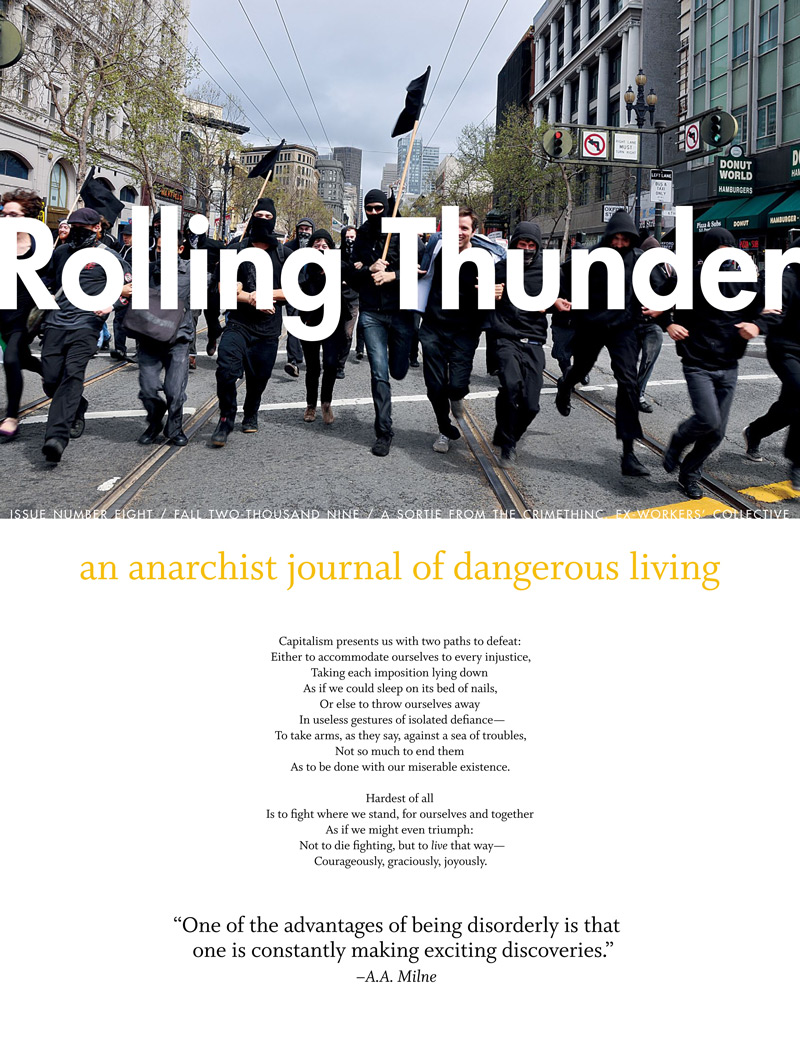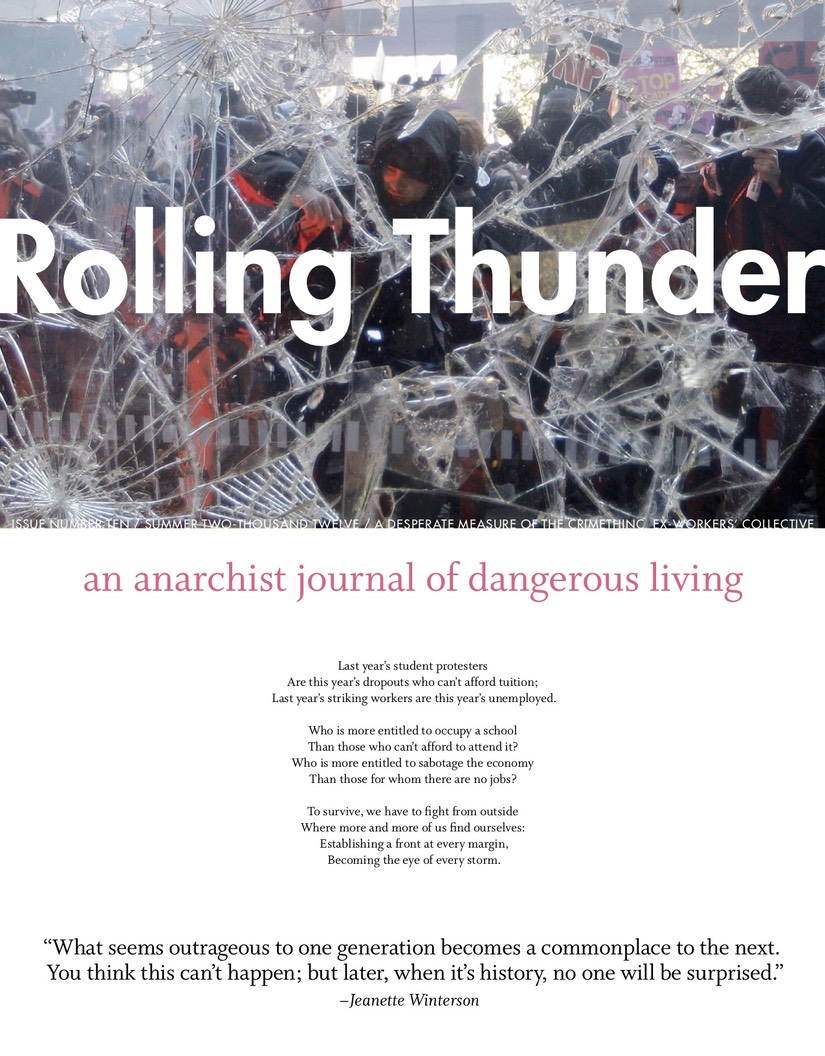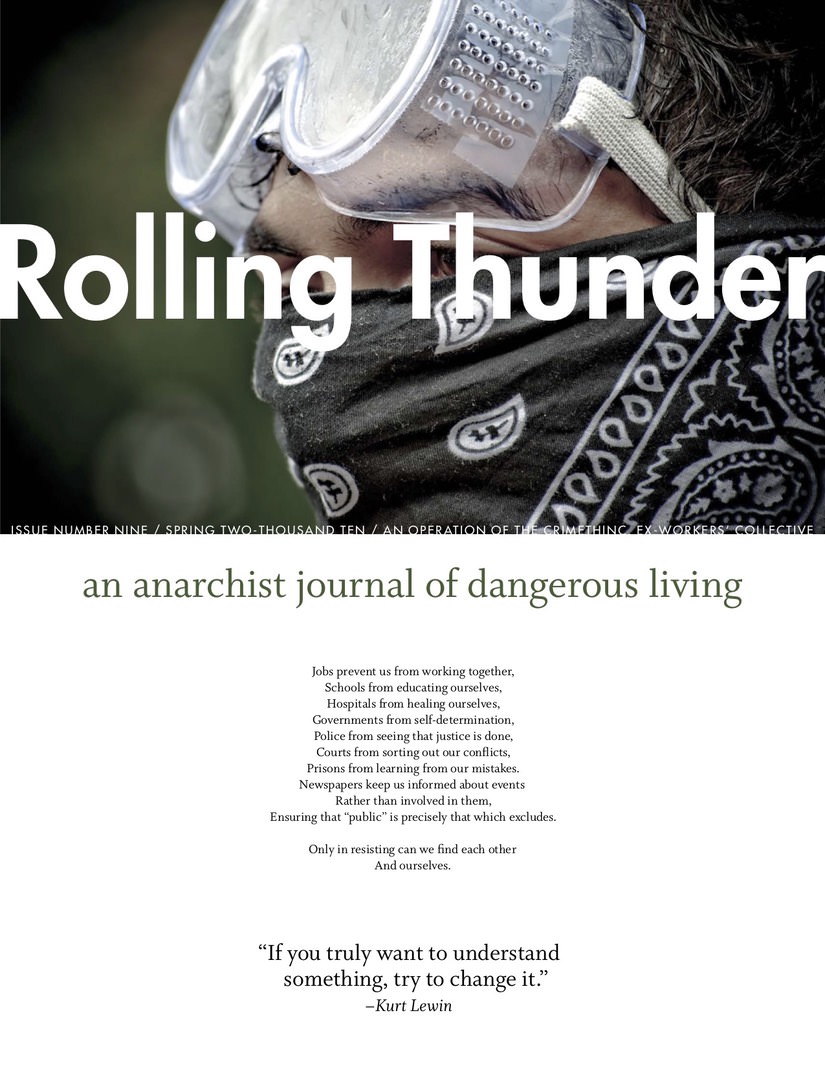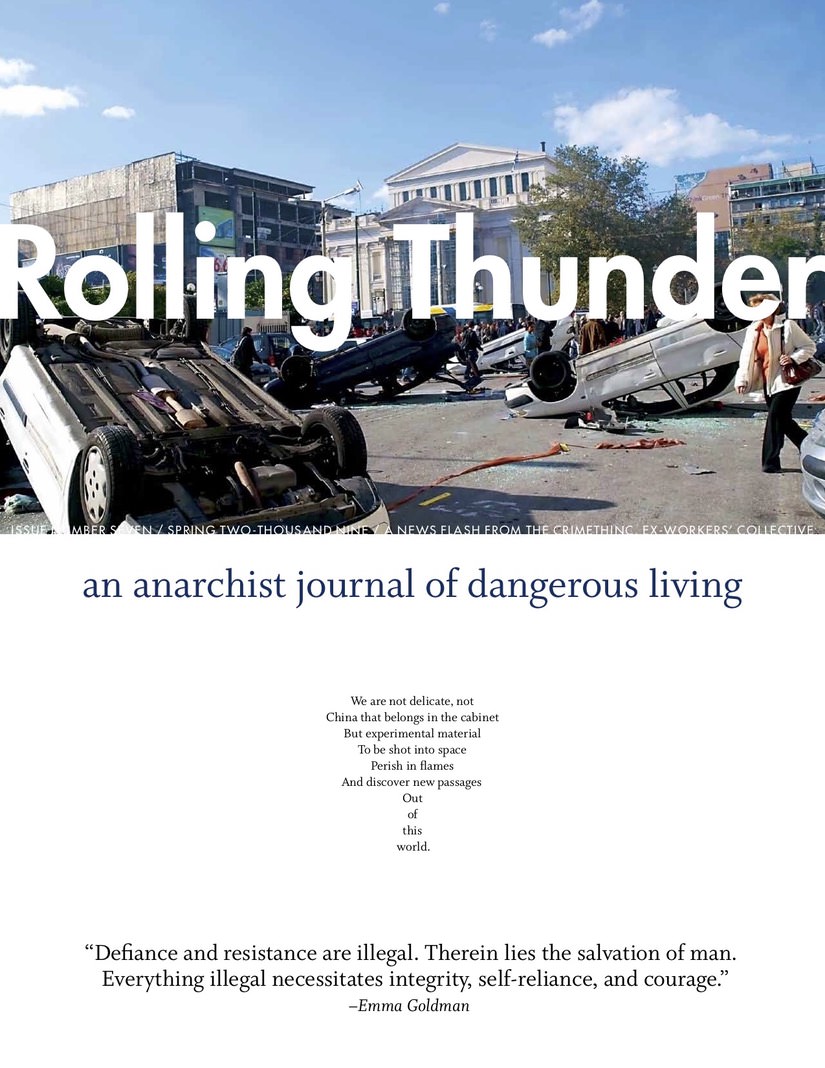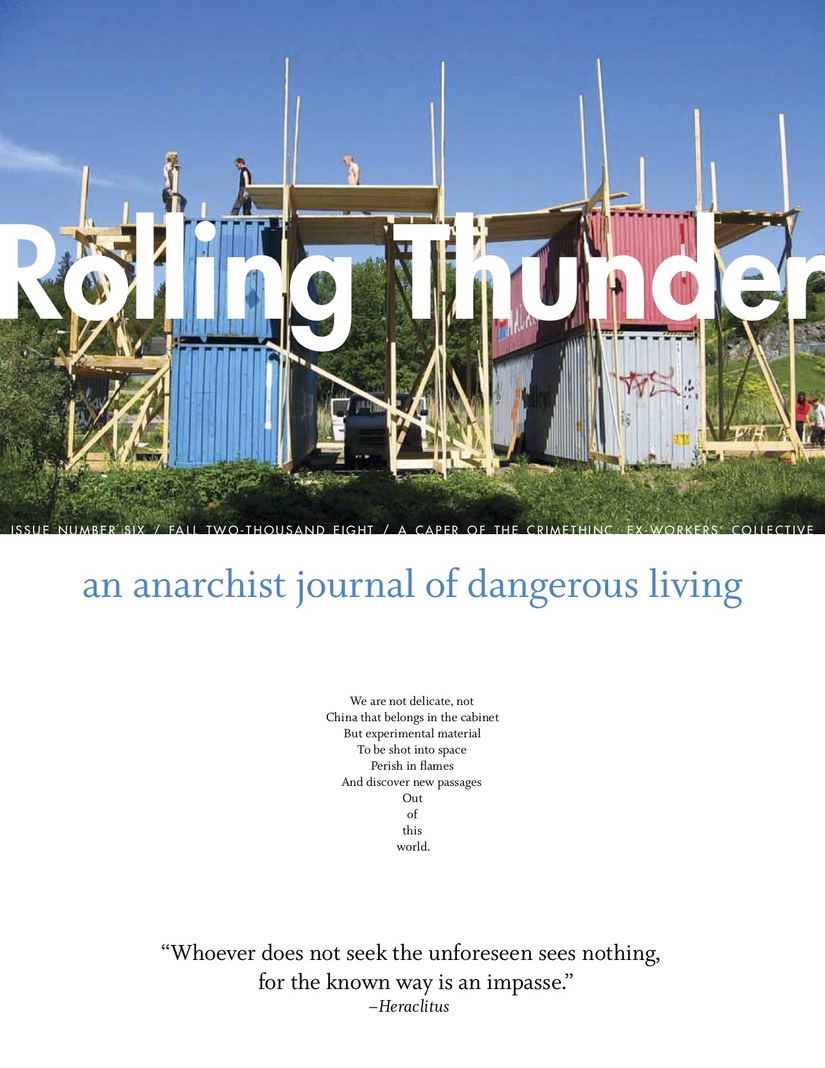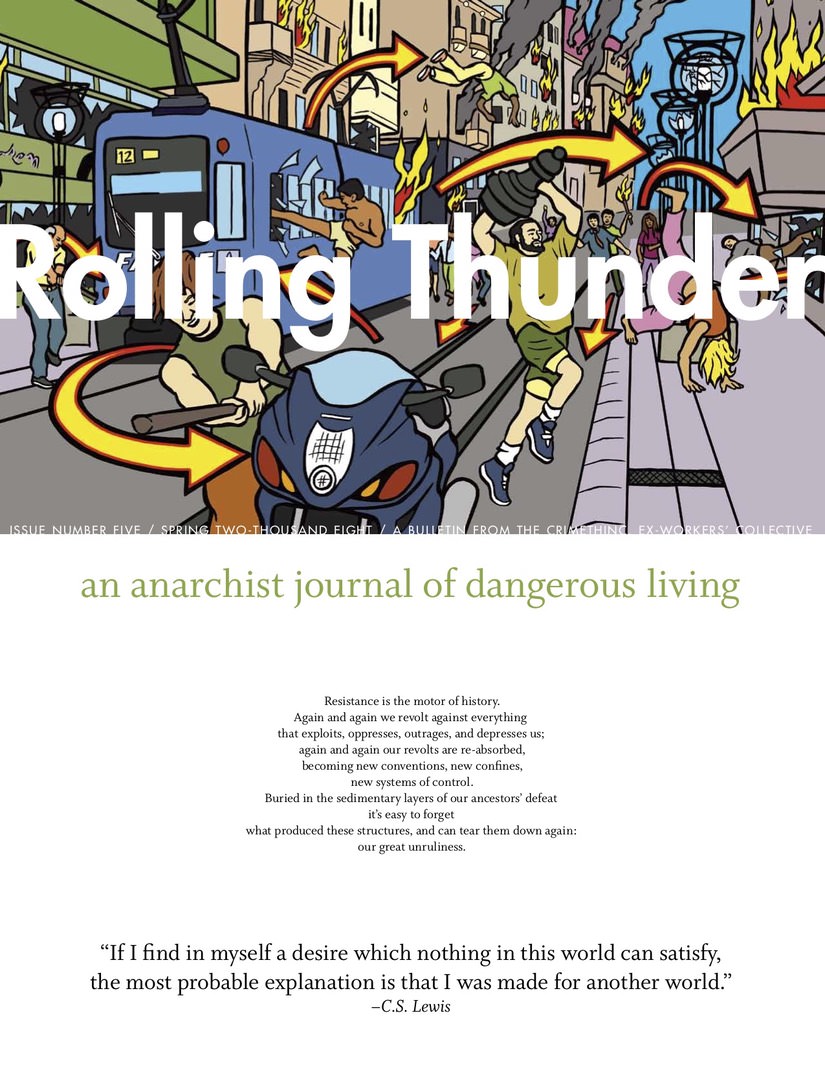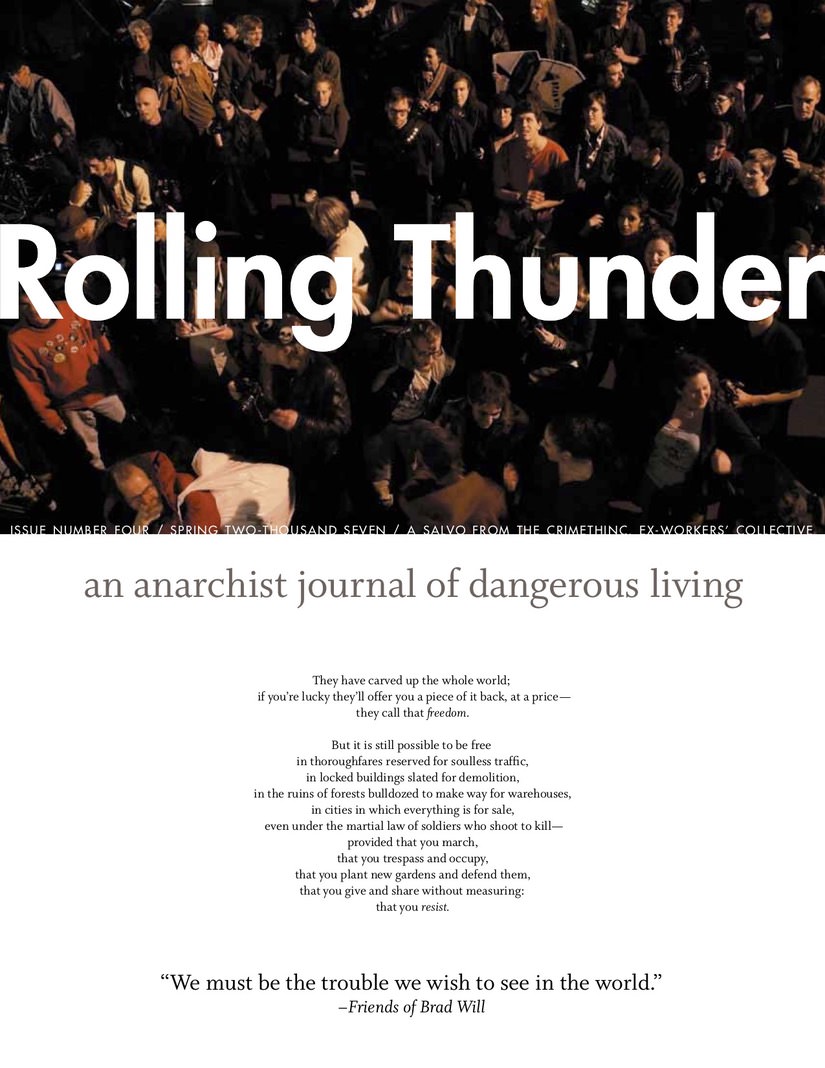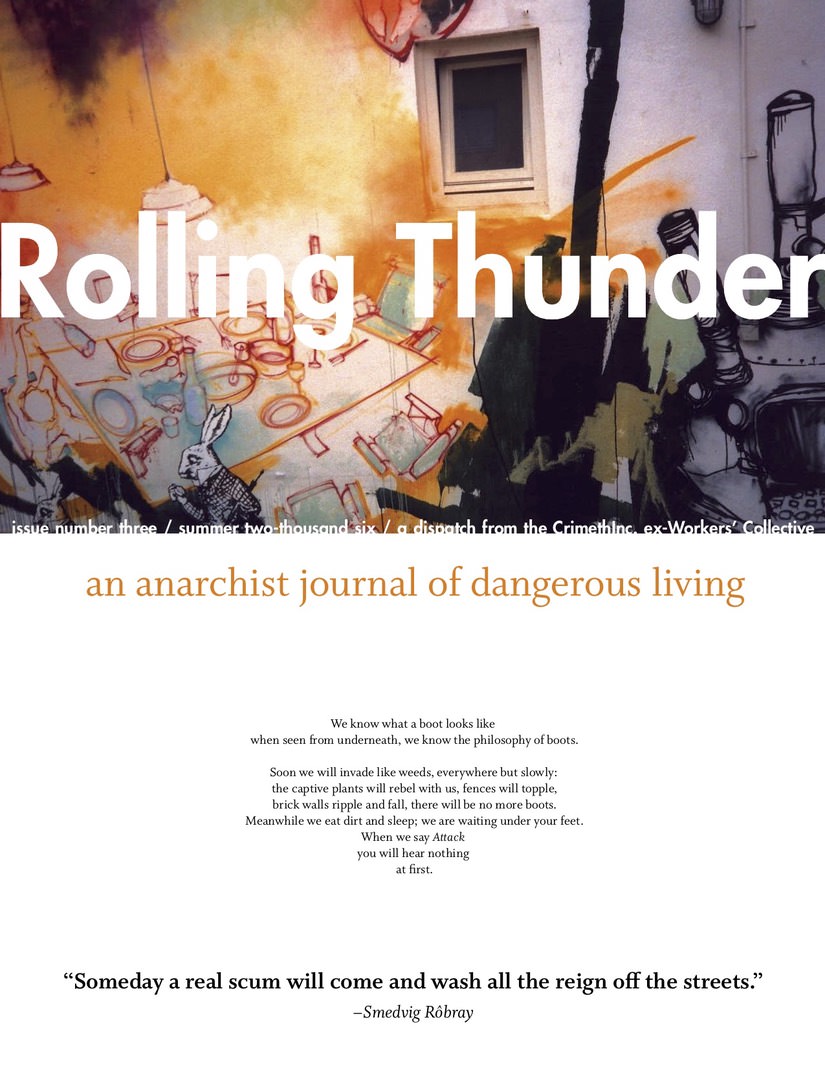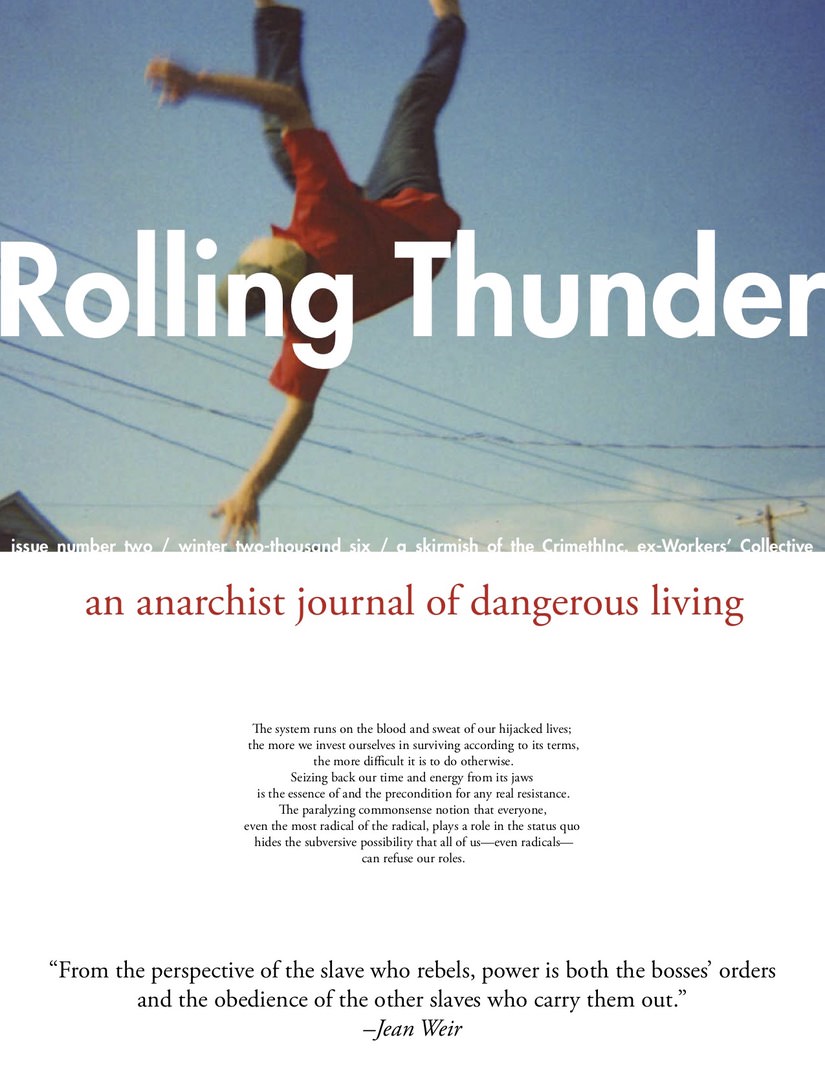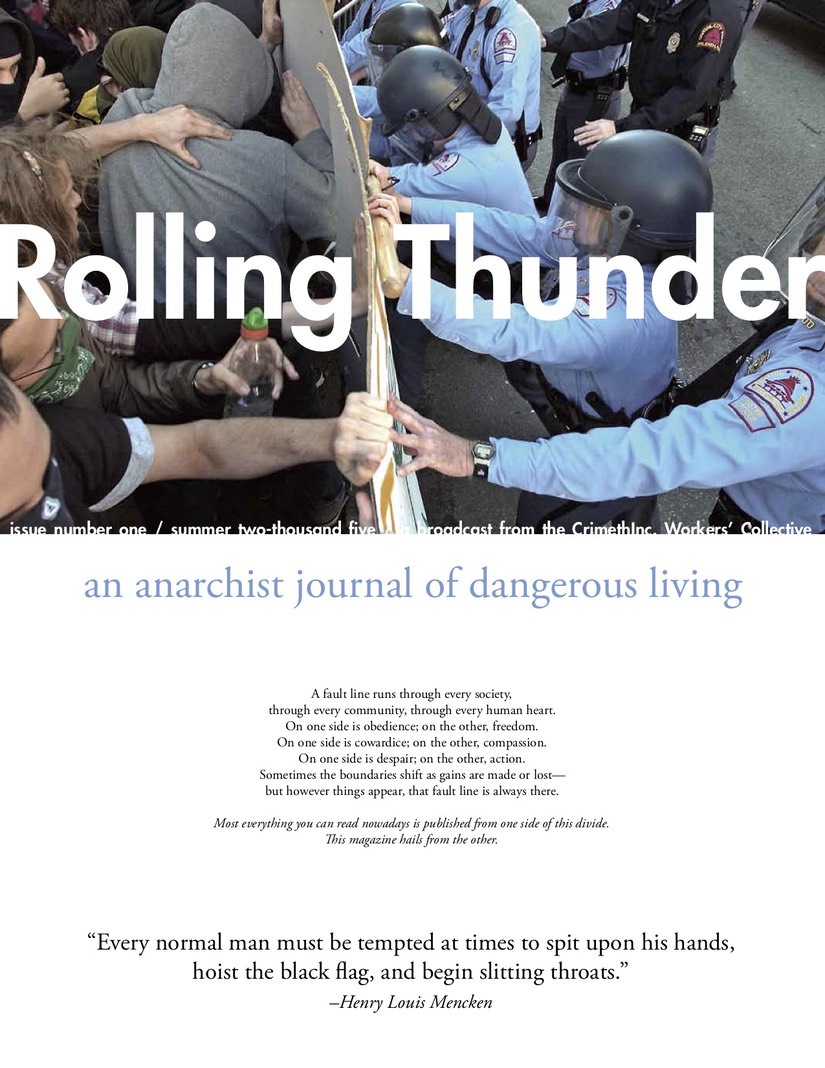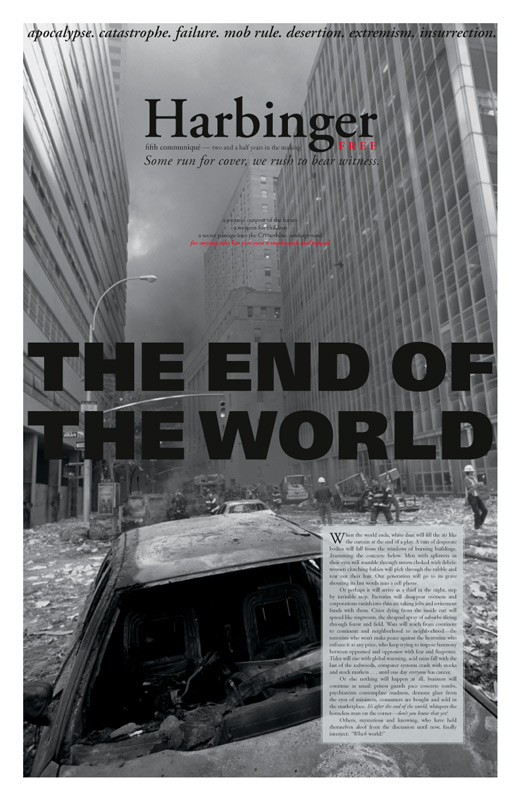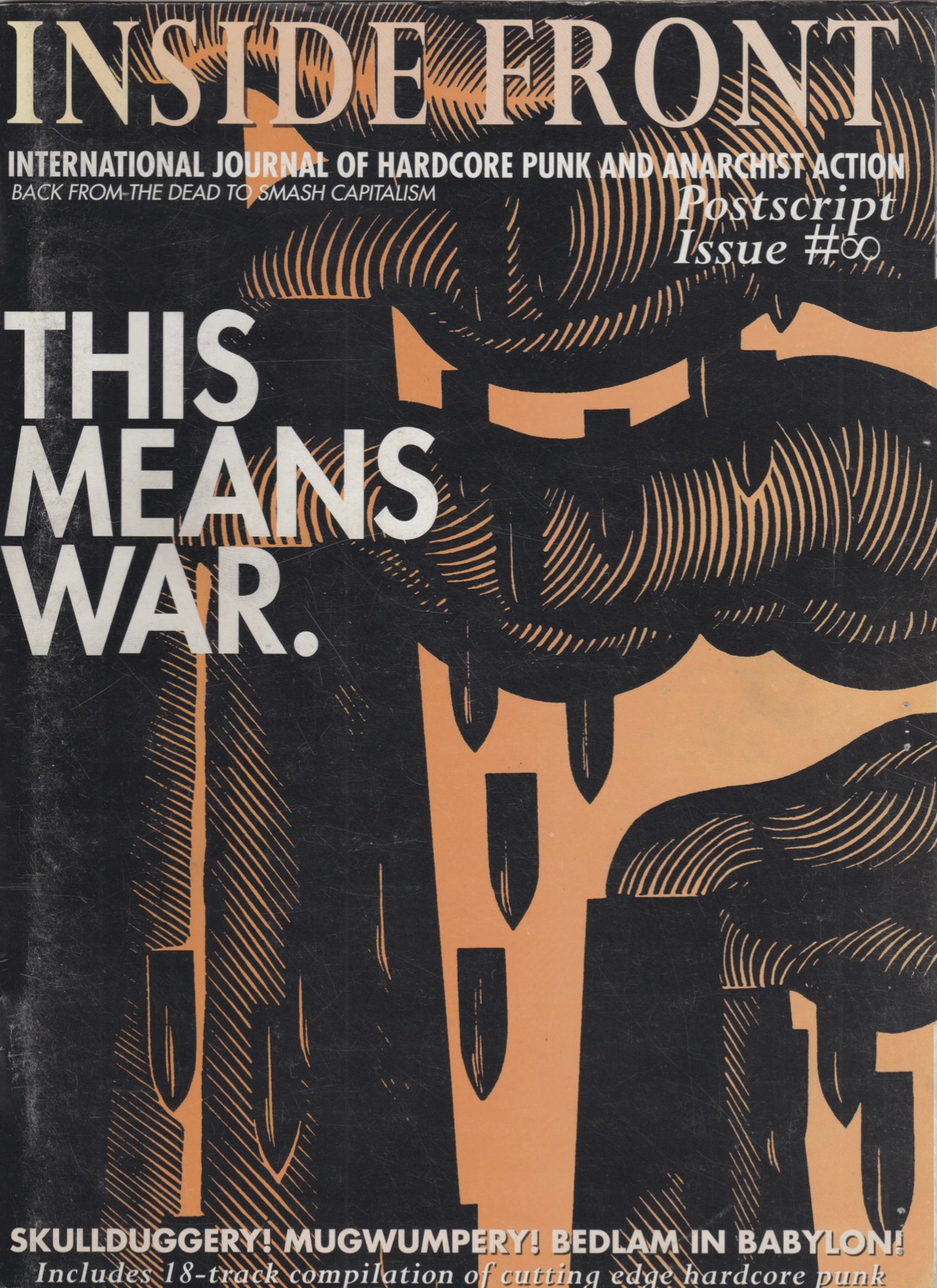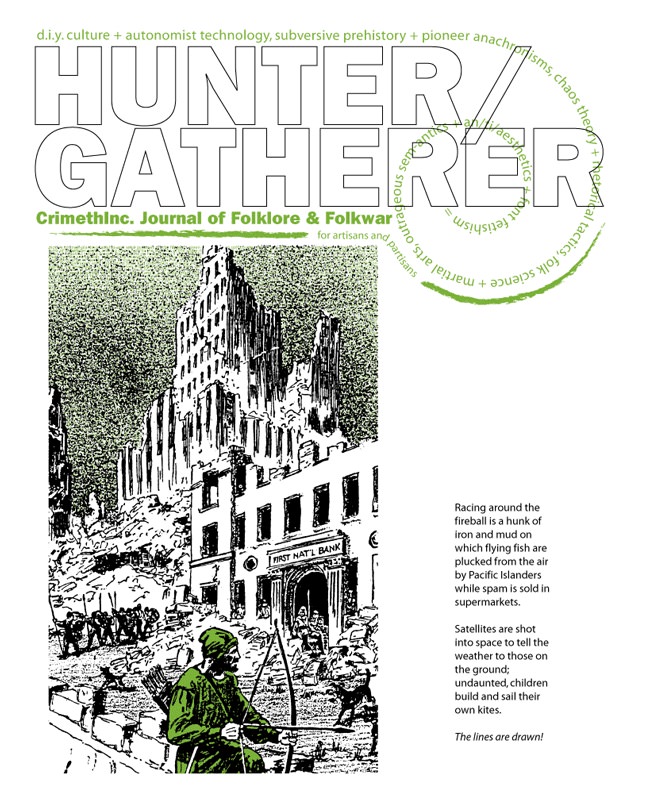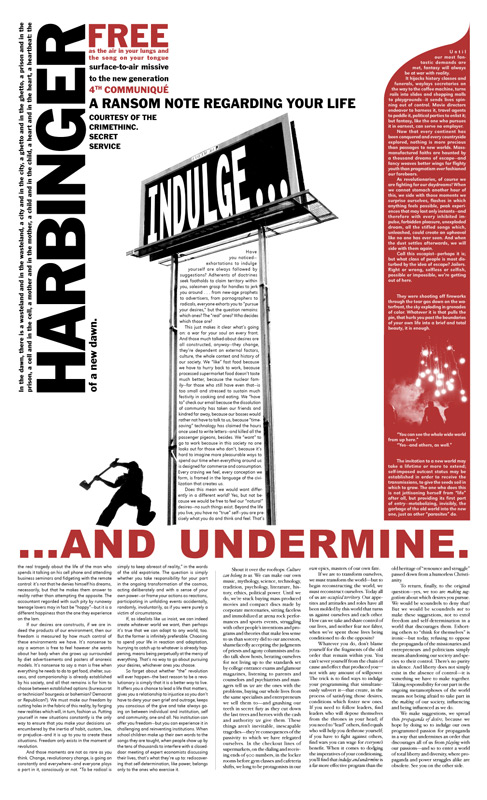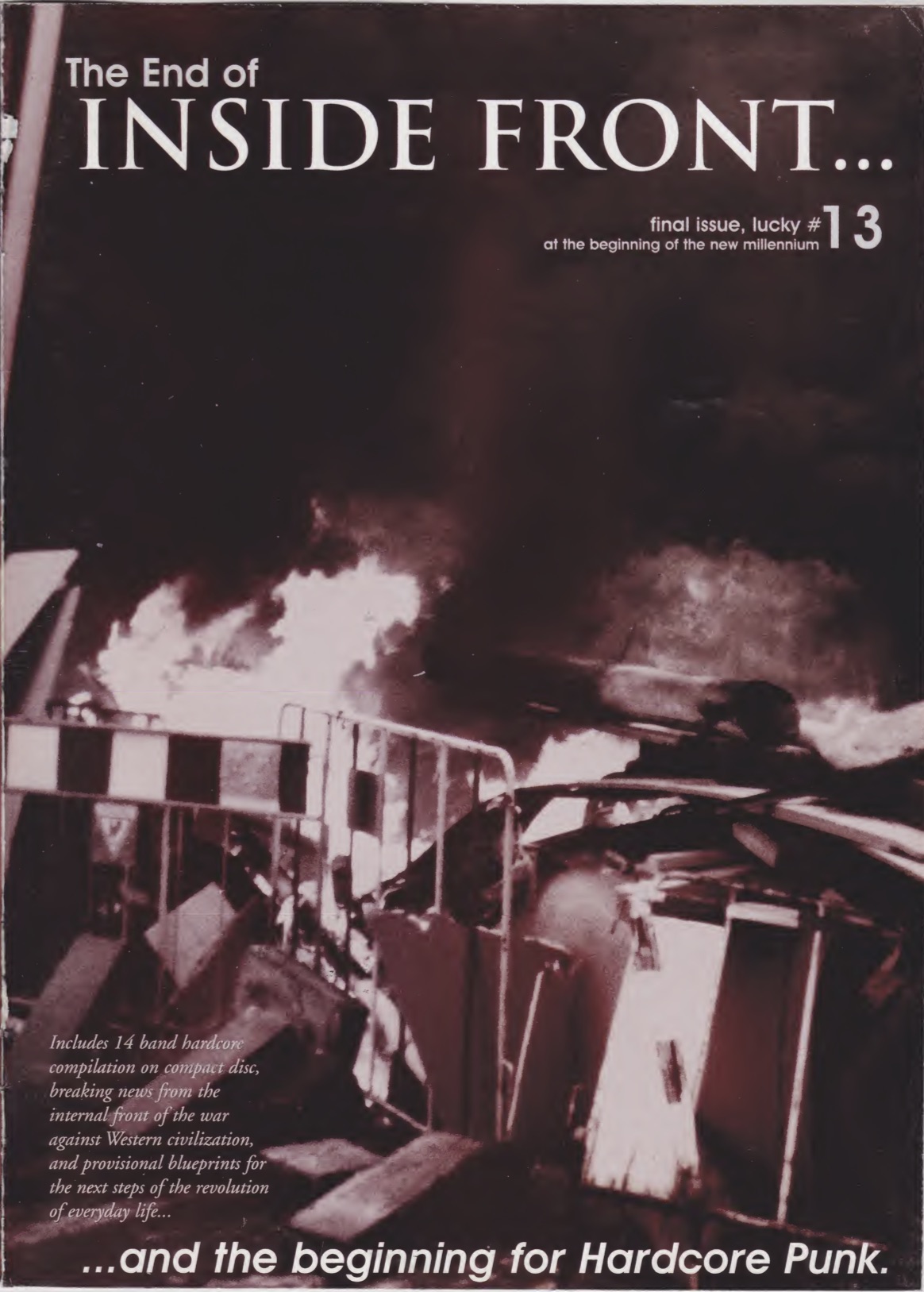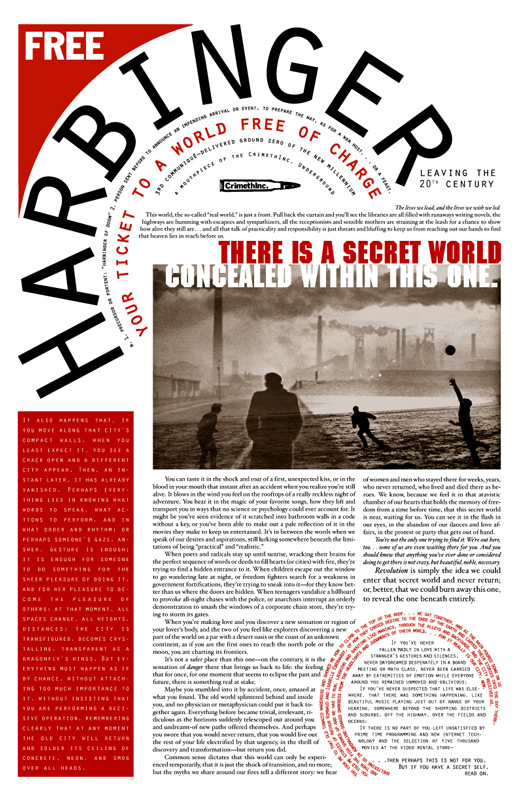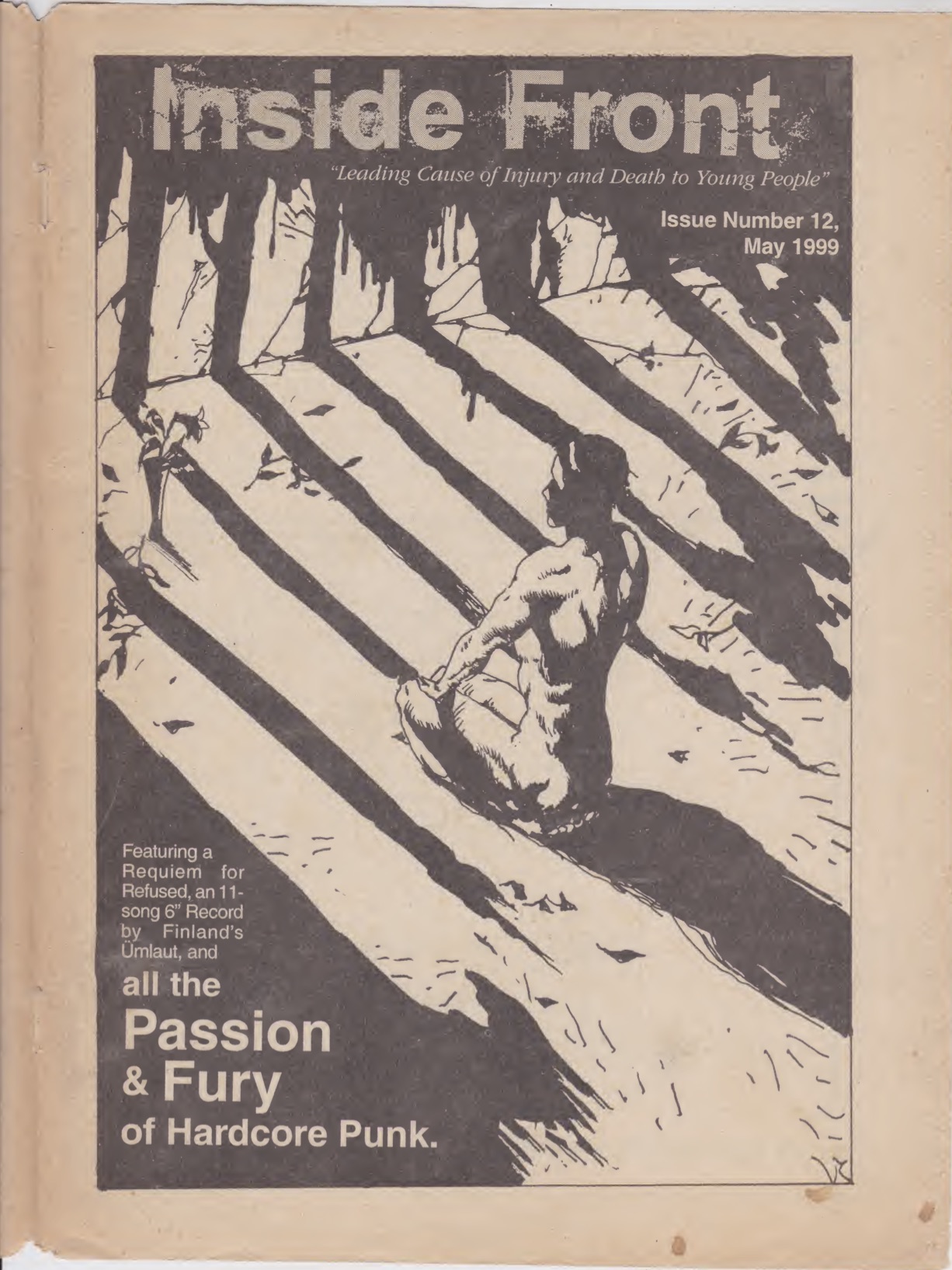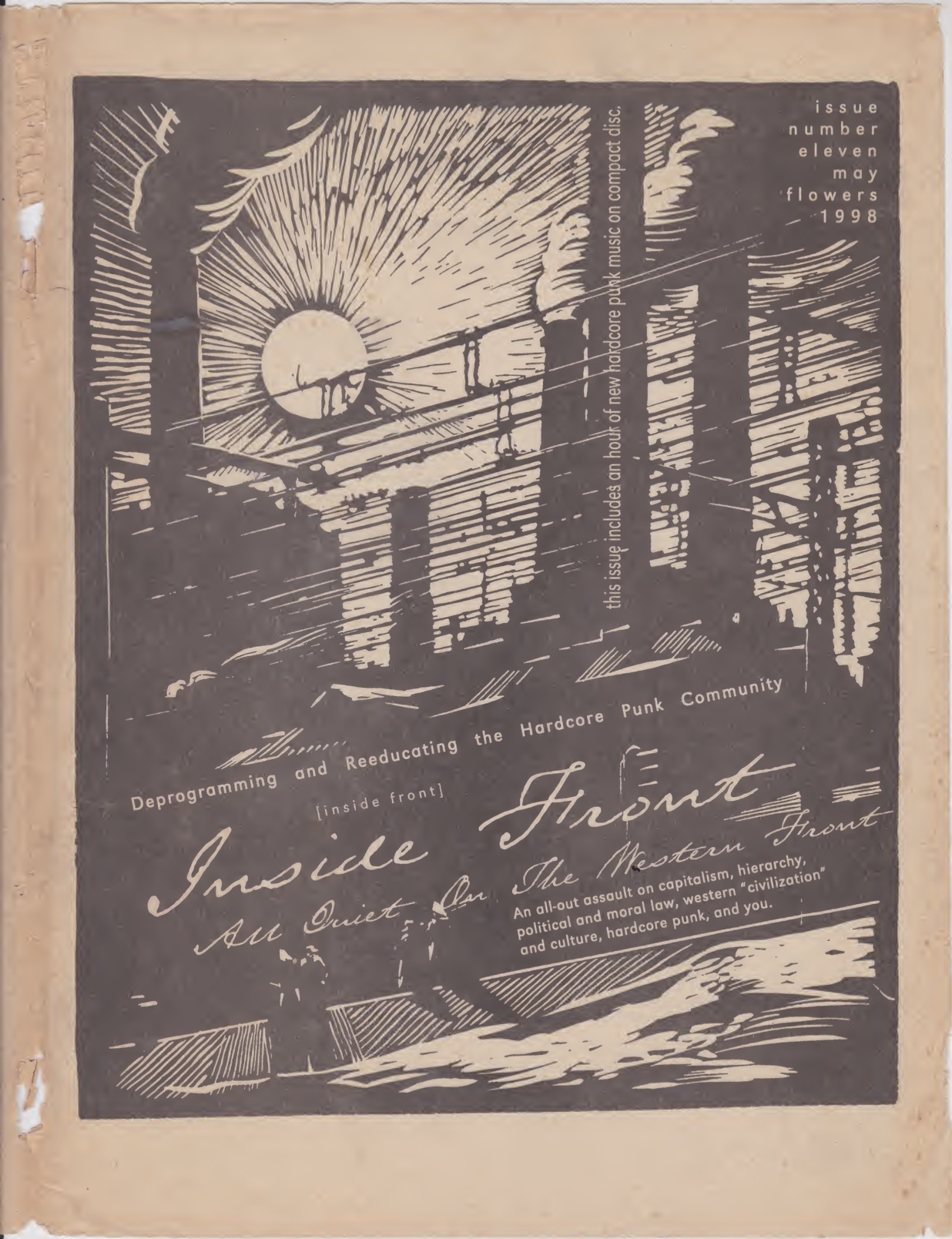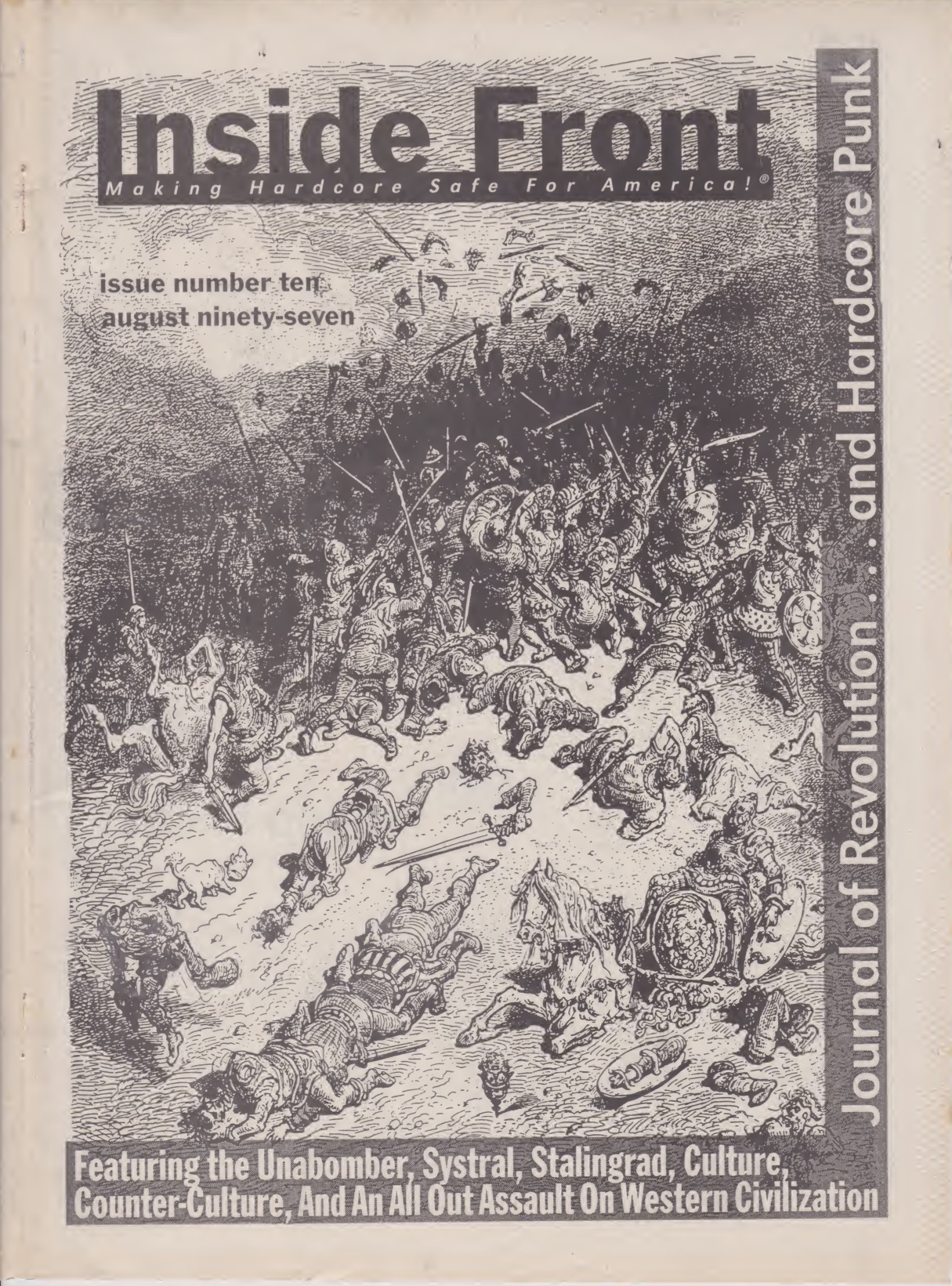Journals
Here, you can download PDFs of Rolling Thunder, our acclaimed journal of analysis and direct action, Harbinger, our classic tabloid spreading “the propaganda of desire,” and other ambitious serial publications from the past two decades.
The centerpiece of this issue is a 64-page feature on the uprising against police and white supremacy that spread from Ferguson, Missouri across the United States. We urge everyone to read the debrief discussion in which Missouri anarchists reflect on their role in predominantly black struggles and the ramifications of joining confrontations that include arson and gunfire. This is filled out with raw and inspiring accounts from the streets of Ferguson, Oakland, and beyond—critiques of political cooptation and the politics of demands—narratives about destroying surveillance cameras—a discussion about the function of biopower in jails and cancer wards—anarchist analyses of sex work—interviews with Turkish anarchists who participated in the resistance to ISIS in Kobanê—poetry of the Egyptian revolution—comics about the celebrated riot dog Loukanikos—the life of Biófilo Panclasta—history vs. mythology—tactics vs. strategy—peace vs. justice—and much, much more. All this, plus our regular features, gorgeous artwork and photographs, and 16 pages in full color. Fully 154 pages!
This one goes to eleven! The second series of Rolling Thunder opens with an issue full of adventure and analysis. Whether you’re a committed revolutionary looking for the latest strategic reflections from the front lines, or you simply enjoy the gripping tales of suspense and subversion, you can’t get this stuff anywhere else. An epic account of prisoner resistance from Sean Swain—an exploration of the waning phase of social movements, including case studies of Occupy Oakland and the 2012 student strike in Québec—a narrative from the epicenter of the uprising that rocked Turkey in June 2013—devastating critiques of ally politics and the ideology coded into digital technology—a tell-all history of anarchism in Israel—a new look at gentrification, through the frame of one neighborhood’s struggle against development—a review of the forgotten insurrectionist text that taught Nietzsche, Borges, and Walter Benjamin about infinity. All this, plus our regular features, gorgeous artwork, 16 pages in full color, and a completely new and improved format! At 128 pages, this is our thickest issue yet.
Balancing out the previous issue’s focus on breaking news, Rolling Thunder #8 steps back to reflect on the priorities and relationships that can make resistance effective and infectious. The centerpiece of this issue is a critical examination of the strengths and shortcomings of contemporary insurrectionist theory and practice, spanning 24 pages and a wide range of lines of inquiry. Elsewhere herein, one can find a guide to crafting constructive accountability processes, a survey of the past four decades of anarchist activity in Chile, and a report from San Francisco exploring the broader context of anarchist organizing leading up to and following the Oakland riots covered in Rolling Thunder #7. We’ve also turned up a retrospective by a member of the legendary clandestine anti-prison group Os Cangaceiros, distilling the lessons of years of underground struggle. All this is rounded out by inspiring accounts, entertaining anecdotes, magical realist fiction, and much more. No advertisements; 16 full-color pages.
Rolling Thunder #10 begins with a reappraisal of the anarchist project in today’s context of crisis and technological transformation. From there, we chart the global trajectory of momentum from 2010 to 2012: the student movements in the US and UK—the insurrections in Tunisia, Egypt, and beyond—the occupation movements in Spain, Greece, and finally the USA, from its awkward beginnings in Wisconsin to its aftereffects in Oakland. For case studies, we focus in on the anti-police struggles that catalyzed the rise of confrontational anarchism in Seattle, and scrutinize how US immigration policy is applied on the ground at the border to explain how its actual objectives differ from its ostensible purpose. The issue concludes with a historical review of Canadian anarchism, following it from its origins through the 2010 Olympics and G20 riots and up to the present day. All this, plus a graphic history from Argentine anarchism, 24 pages in full color, and all the other bells and whistles you’ve come to expect from us times two.
How important is legitimacy—in our own eyes, in the eyes of potential allies, in the eyes of the public? How can anarchists cultivate it? What pitfalls does it hold? Rolling Thunder #9 explores these questions while reporting on the past six months of upheavals around the US. Following up on our coverage of the 2008 convention protests, this issue assesses anarchist action at the 2009 G20 summit, mapping conflict throughout the city and analyzing the strategies of the police and protesters. The accompanying Pittsburgh scene report examines the decade of local organizing that prepared the ground for this and other confrontations. Elsewhere herein, we scrutinize protest and resistance on campus—from the recent occupation movement to efforts to shut down fascist student organizations—and overseas in the Smash EDO campaign. All this, plus obscure Russian history, a reappraisal of the concept of “free speech,” and the usual stunning prose. No advertisements; 16 full-color pages. Check out the online supplement to this issue.
So much happened in the second half of 2008 that we had to put off all our other content and add an extra 8 pages just to cover it all. Anarchists coordinated mass mobilizations against the Democratic and Republican National Conventions, provoking major clashes; the global economy collapsed; Greece experienced an anarchist-organized insurrection in response to a police murder; and at the beginning of 2009, Oakland was shaken by similar unrest. Our coverage pushes beyond the surface of events to offer insight into the organizing structures and historical background, fleshing out timelines and analyses with personal narratives and cutting-edge cartography. In addition to all this, the issue includes an exploration of the relationship between the punk subculture and the anarchist movement, complemented by interviews with bands and collectives from beyond the white punk ghetto, and ends with a primer on small-town organizing using Winona, Minnesota as a case study. No advertisements; 24 pages in full color.
The theme of Rolling Thunder #6 is experimentation: the processes by which radicals invent and refine new approaches. To this end, it features an evaluation of the model activists have used to target the animal testing corporation HLS, discussing whether it could be effective in other contexts; a photoessay documenting the efforts of Swedish anarchists who, unable to defend a squat, built a social center from the ground up; a consideration of the role proper support plays in cultivating communities of resistance; a report from student strikes and riots in Colombia; and an analysis of the past decade of anarchist organizing in NYC. In addition, the issue includes an investigation of the function of gift shops in maintaining global empire, historical accounts of Bakunin’s daring escape from Sibera and the riots that killed off the hated poll tax in Britain, and lots more. As usual, there are 16 pages of full color, plenty of fun tidbits, and no advertisements.
This issue focuses on different ways of conceptualizing strategy, exploring the ways anarchist efforts can be repressed, assimilated, and neutralized only to reappear in new forms. It opens with a study by David Graeber of the successes and stumbling blocks of direct action movements over the past thirty years, followed by a special report distilling lessons from the recent wave of federal repression known as the Green Scare. Two features give the inside story on anarchist mobilizations overseas via interviews, personal narratives, and 16 pages of full color photos: an examination of the riots following the eviction of Denmark’s beloved social center Ungdomshuset, and a full review of last summer’s G8 protests in Germany. The issue is rounded out by a subject’s analysis of the medical study industry as a case study in modern day precarious labor, a spotlight on anarchist organizing in Modesto, California, and reviews of controversial works by anti-art duo Brener and Schurz. As always, 100% ad-free.
The centerpiece of the fourth Rolling Thunder is a full-color photoessay chronicling the popular uprising during which the people of Oaxaca, Mexico wrested control of their city from the government for a period of months. Continuing that theme, other feature articles cover the defense and eviction of South Central Farm in Los Angeles, the Really Really Free Market as a model for reclaiming public space from capitalism and bureaucracy, the resurgence of squatting in Buffalo of all places, the university occupation movement in France, and the ins and outs of urban exploration. The remainder of the issue includes a comprehensive guide to supporting prisoners and defendants, the lyrics to “The Big Rock Candy Mountain” as interpreted by acclaimed comic artist Nate Powell, a gallery of ready-to-use stencils, and plenty of the edgy artwork and poignant prose you’ve come to expect. Still 100% ad-free.
International reports from last Mayday’s pro-immigrant rallies! Analysis of the Bush regime’s strategy to promote terrorism worldwide! Discussion of the latest wave of federal repression! Testimony from a convicted anti-war arsonist! Anarchist perspectives on and reports from the struggle against domestic violence! A tell-all interview with notorious graffiti artist(s) BORF! A shocking exposé on German pro-Zionist lunatics! A how-to guide to funneling resources out of universities! A spy’s-eye-view of immigrant labor in factory farming! A narrow escape from the flaming Pentagon on September 11, 2001! A history of direct action and rioting in queer liberation struggles! A cartoon recounting the riots at the canceled World Bank conference in Barcelona! A mad-lib for radicals with poor social skills! A satirical guide to writing reviews! Visionary storytelling, technical advice on computer security, eulogies and poster designs and more, more, more! 100% advertisement free.
The lengthiest articles in our second issue are an analysis of last summer’s protests against the G8 meeting in Scotland, a retrospective on squatting and resistance culture in northern Europe, and an in-depth discussion of subcultural marginality and refusal that is to dropping out what the first issue’s sixteen-page feature article was to protest activism. The last of these is rounded out by an inside report on the workings of current labor unions, a memoir of gender mutiny, and an account of how to establish a squatted community center; other highlights include an intimate reflection on the patterns by which abusive relationships perpetuate themselves and a primer on communications technology for direct action. This issue also features plenty of the unorthodox fare that distinguishes CrimethInc. projects from the sometimes listless work of other radicals: a haunting fairy tale, cutting edge games to play between more serious adventures, a crossword puzzle, and sheet music for a classic blues song about the preponderance of bread products in the dumpsterer’s diet.
The debut issue includes an extensive analysis of the preceding decade of direct action, feature articles on consent in sexual relationships and alternative conceptions of education, and testimonials from maniacs who squatted their own workplaces and set themselves on fire while fighting police… and that’s just the beginning! All told, this is 116 pages of radical commentary, history, poetry, artwork, fiction, parlor games (!), comics (!!), skills (e.g., “how to survive a police raid”), and culinary advice, all with an emphasis on personal narratives and celebrating the ways subversion thrives in the most unlikely places. 85,000 words adorned with tons of photos and illustrations and not a single advertisement, printed on recycled book paper and square-bound with the fanciest cover we’ve ever produced.
Nearly 200 pages of fine print, including early versions of texts that later appeared in books such as Recipes for Disaster and many other strange and wondrous gems. The content runs the gamut from interviews with Tragedy, Lack, and other classic hardcore bands—to critical essays about veganism, straight edge, and other rebel lifestyle commitments—to narratives detailing the experiences of young hooligans going into open battle against the G8 and other international capitalist organizations. In one account, the author hitchhikes across the UK to the Isle of Skye to meet the Baron, the bassist of Amebix, who has retired there to forge medieval swords.
From the vantage point of the present day, this is an extremely rich time capsule of another era, when anarchism, adventurism, criminal recalcitrance, and MAXIMUM ULTRAISM mingled together to present an alternative life path to conformist participation in the dominant order. It’s a heady mix.
The penultimate issue of Inside Front begins with a narrative in which the editor and other young ruffian stage a guerrilla noise show at 2 am in a convenience store immediately across a parking lot from a police station. Police pull up to the store and see the crowd moshing and rioting, throwing commodities everywhere with wild abandon—and the issue proceeds from there, including accounts from the riotous high points of the anti-globalization era of summit hopping, essays about non-monogamy, travelogues from several continents, and, of course, a snapshot of the most extreme currents in the do-it-yourself hardcore punk underground at the turn of the century.
This issue of this hardcore punk journal includes a massive interview and retrospective on the influential Swedish hardcore band Refused, qn interview with seminal Brazilian vegan straight edge band Point of No Return, articles about everything from the Situationists to the rebel credentials of electronica vis-à-vis punk music, an account from one of the first Reclaim the Streets actions in the United States, and a great deal more.
Early CrimethInc. articles analyzing hierarchy, anarchy, and moral law; a retrospective on the legendary Amebix; interviews with Zegota and Ire; columns by such luminaries as Al Burian of Burn Collector fame and Greg Bennick from Trial; and a great deal of coverage of the mid-1990s international do-it-yourself hardcore scene from the earnest yet irreverent perspective of fire-eating rebel youth.
As the cover puts it: the Unabomber, Systral, Culture, counter-culture, and an all-out assault on Western Civilization.
